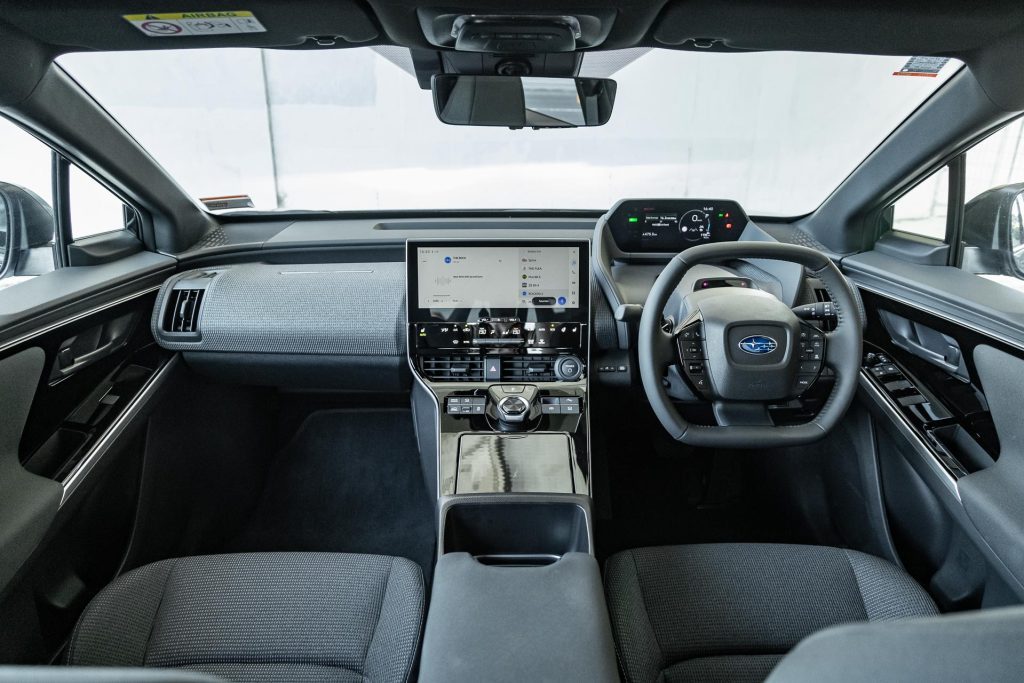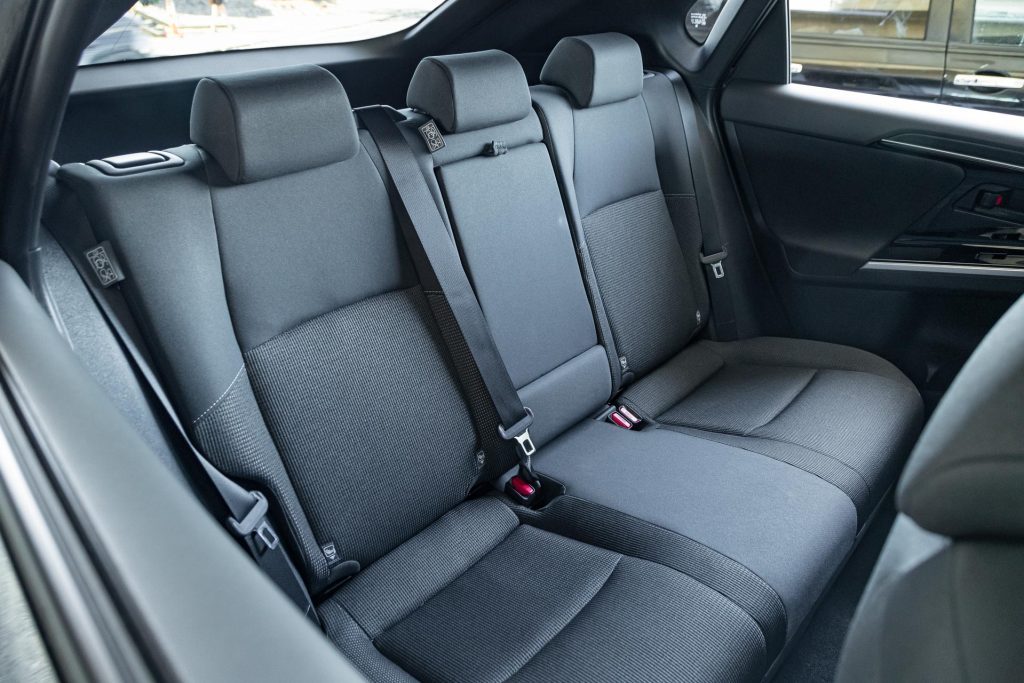2024 Subaru Solterra review
Words: Kyle Cassidy | Photos: Isaac Western
Subaru enters new territory with the arrival, finally, of its first electric vehicle, Solterra. It’s got AWD naturally, and modern SUV styling but is it Subaru enough?
The Subaru Solterra has arrived late to the EV fest here in NZ as the appetite for amps has cooled now that the inducements have been axed.
Any residual demand will take some time to recover as people sit back and do the sums; ICE cars are now cheaper without the fees, and the EV free ride is over with RUCs incoming.
That erodes the total cost of ownership argument, at least until the government signals what road tax will look like for everyone, with talk of RUCs for all.

We’re now back to focusing on ‘is the EV worth its premium?’ But you should take more than just dollars into account as there are other less quantifiable benefits of going electric. One of these is refinement.
To drive, Solterra reminds of the Lexus RZ, because it is essentially the same underneath, spun off Toyota’s e-TNGA electric platform.
It inherits similar drive refinement but this rides better without such big wheels, the base Solterra on 18s with 60 profile rubber. The hoops give this more of an SUV vibe too, to go with its excess of plastic body cladding.
You don’t notice it so much on this black car, just all the dirt. And that it absorbs the heat of summer. Don’t buy a black one.
The power delivery is civilised. There’s a total of 160kW and 338Nm from the twin-motor set-up, modest yet entirely adequate here. And it’s delivered in a measured way, yet it never feels wanting.

For those who want more urgency, it’s there in the Power mode.
The steering is sorted too. It’s not overly light but the assistance is consistent. It’s reasonably quick as well, and the turning circle is okay for a dual-motor electric, at 11.2m.
The odd steering wheel never feels quite right though. It’s set low too, so you can see the instrument panel (digital but non-configurable) above it. That puts it in your lower peripheral vision, so speed is easily legible.
There are varying degrees of motor regen, stepped through via the paddles from nothing to a one-pedal mode. Well, nearly, as you still have to bring it to a complete halt with the brake pedal.
We like that you can tinker with this, helpful both in and out of town as you can maximise your coasting opportunities and your regen if you pay attention, which helps bring the consumption down and extends the range.

So what is the range?
The 71kWh battery has a usable capacity of 64kW and Subaru NZ quotes 485km but that’s NEDC. The WLTP figures are between 416 and 466km.
Something closer to 400km is more likely, and likely less in winter. Roaming around town in warm climes, this was averaging 16.7kWh/100km, which is probably about as good as it gets.
As to charging it’ll take on DC flows at a max rate of 150kW and up to 11kW AC with a three-phase wall box. On a 180kW charger, we only saw a max of 100kW, 40-80 per cent uptick taking 20 mins.
Another charge at a 50kW DC unit raised it from 14 to 44 per cent in 30 mins. On the trickle charger, 12 hours dispensed 24kWh (battery from 30 to 58 per cent).

Though there is no user app, you can schedule the charging start and stop times via the car’s touchscreen, so you can make use of off peak rates (when all at-home charging should take place).
A Subaru though?
We bumped it along a rutted trail, and traction certainly isn’t an issue. A plus for electric power is the absolute control of wheel slippage and with motors at both ends, it’s sticky.
While the 210mm of ground clearance is similar to both Subaru Outback (213mm) and Forester (220mm), the front overhang needs a bit of caution, and with its long wheelbase the ramp over angle isn’t as good.
There’s an X-mode for snowy situations though.

Being a Subaru, we needed to belt it down a gravel track, and it took this in its stride. The ride remains calm, even through the rough corrugations and it tracks nicely in the deeper gravel.
The stability control is quick to arrest any antics. We noted a layer of dust in the cabin afterwards so maybe the sealing isn’t quite as tight as it could be.
The supple ride character remains on highways, where it’s also quiet on the go. The steering gets it turned quickly and while a tad more feel won’t go astray there aren’t any weird weighting issues to deal with.
The throttle response is easy to modulate, with enough power at a quicker pace. There’s a tendency to understeer when pushed, the tyres the limiting factor, but it’s decently balanced so you can hold it on line without tipping the rubber into overload.

And with AWD, it has good squirt off the curves. The brakes feel decent too, with a progressive feel when you lean into them.
Paddling through the levels of regen can be enough to slow you for bends, which makes this an easy drive.
We didn’t notice the lane keeping on the winding roads, but it likes to nudge you about on the highways and motorways, so best up your lane discipline.

Practical too?
The cabin is a mix of fabric and plastic, enough of the latter being soft to the touch. There’s some shiny piano black surfaces too that mark a little too easily and reflect the sun too well.
While there’s no glove box, there is enough storage about the place, a bin under the floating console for instance.
The seats are decent – we generally prefer fabric over fake leather – and they are heated front and rear (a more efficient way to stay warm in winter than running the heater full-bore).

We couldn’t get the voice control to wake up (were we saying sa-bar-roo instead soo-boo-ru?) but touching the mic button summoned it and it was then able to decipher our intent and take care of most common commands (sat nav destinations, temperature control, audio settings).
This is closer in overall height and width to the Outback but it’s not as long overall, being just 50mm more than the Subaru Forester.
But it beats them both in wheelbase length, that space given over to the passengers mainly. There’s a heap of room in the rear, even for the legs of an occasional third bod in the middle.

The boot is practically shaped too and the split folding gives lots of additional length. There’s no spare wheel but some underfloor space for cables.
This had a tow bar fitted, a nice installation, though we had nothing to tow. It’s only rated to 700kg, so light duties really but it’ll fit the bike carrier securely, having a solid flange to it.
Need the Touring?
Not really, as there are only minor differences in spec between the models, wheel size (20s on the Touring), a glass roof, fake leather and a hi-fi system.
The only thing we’d really yearn for is the charge pad. There’s no difference in safety between them.

Most of the gear is worth having; the driver monitor will make sure your eyes are always on the job, and the 360 degree camera is a good one with clear imaging.
The entry model has the same 12-inch touchscreen as the Touring with sat nav and CarPlay and Android Auto.
Worthy?
Now that the fees are gone, Subaru’s mainstream models become cheaper, given they all previously copped a penalty. The biggie for the Solterra is the lack of the sweetener.
And so it’s a big $14k walk up from the Outback. But those still keen on an EV in this price bracket should check this out.

It’s cheaper than other similarity sized, dual-motor options (apart from the Toyota version of this, that is), and while it’s lacking in ultimate range, it’s one that drives well and has a distinctly refined nature about it.
This article first appeared in the March 2024 issue of NZ Autocar magazine.
| Model | Subaru Solterra |
| Price | $79,990 |
| Motor | 160kW, 338Nm |
| Battery | 71kWh net |
| Range | 416-466km |
| Drivetrain | single-speed auto, e-AWD |
| Energy Use | 16kWh/100km |
| C02 Output | 0g/km |
| 0-100km/h | 6.90sec |
| 80-120km/h | 4.70sec (129m) |
| 100-0km/h | 37.10m |
| Stability systems | ABS, ESP, TV |
| Safety | AEB, ACC, BSM, LDW, RCTA, ALK, AHB |
| Luggage capacity | 420L |
| Tow rating | 750kg |
| Service intervals | 12 months, 15,000km |
| Warranty | 3yrs, 100,000km |
| ANCAP rating | Not yet rated |
| Weight | 2015kg (claimed) |





